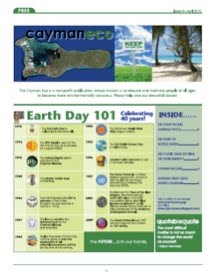BYM Marine Environment News
December 17, 2011
Dr. Guy Harvey applauds decision
but says more needs to be done.
A groundswell of public support
generated by Guy Harvey¹s latest film The Mystery of the Grouper Moon has
prompted the Marine Conservation Board of the Cayman Islands to extend a ban on
fishing the Nassau grouper spawning aggregation site near Little Cayman.
The Board, this week, voted to
extend the current moratorium another eight years after reviewing extensive
research conducted by REEF (Reef Environmental Education Foundation) and Oregon
State University and a public education campaign supported by the Guy Harvey
Ocean Foundation (GHOF) and the Cayman Islands Department of Environment (DOE).
The existing ban, in place since 2003, was due to expire at the end of the
year. The penalty for catching Nassau grouper in a spawning aggregation site
between November and March is up to one year in prison or up to $500,000 in
fines.
"The Cayman Islands are
celebrating the 25 anniversary since the formation of the first marine park
here, so it is fitting that such a strong conservation effort has been made by
the MCB and that common sense has prevailed," said Dr. Harvey.
In filming the research work
being conducted by REEF, Guy Harvey and award-winning filmmaker George
Schellenger created a compelling and informative 45-minute documentary The
Mystery of the Grouper Moon. The film's purpose was to document the research
and make the results available in layman's language to the residents of the
Cayman Islands. The documentary (for a preview go to
http://www.guyharvey.com/home.php?id=5)
was shot entirely in the Cayman Islands and was supported by REEF and the DOE.
The GHOF also supported the education campaign with custom artwork.
More work, however, needs
to be done, according to Dr. Harvey, an internationally celebrated marine
artist and a professor of marine biology, who makes his home in the Cayman
Islands. See the whole story here.
 Cayman News Service
Cayman News Service




 (CNS): Fishermen on Cayman Brac are finding it hard to believe that the nine year ban on catching Nassau grouper at the spawning holes during spawning season has not resulted in a significant increase in groupers, but as Department of Environment staff explained to them at a meeting Monday night, replenishment of grouper populations is a slow process and an extended ban is necessary to ensure that the last viable spawning aggregation (SPAG) site in the Cayman Islands – in the West End of Little Cayman – does not collapse. The fishermen, on the other hand, say they have done their part to preserve the grouper population by observing the ban for nine years and are asking the decision makers to remove it and reintroduce catch limits.
(CNS): Fishermen on Cayman Brac are finding it hard to believe that the nine year ban on catching Nassau grouper at the spawning holes during spawning season has not resulted in a significant increase in groupers, but as Department of Environment staff explained to them at a meeting Monday night, replenishment of grouper populations is a slow process and an extended ban is necessary to ensure that the last viable spawning aggregation (SPAG) site in the Cayman Islands – in the West End of Little Cayman – does not collapse. The fishermen, on the other hand, say they have done their part to preserve the grouper population by observing the ban for nine years and are asking the decision makers to remove it and reintroduce catch limits.




